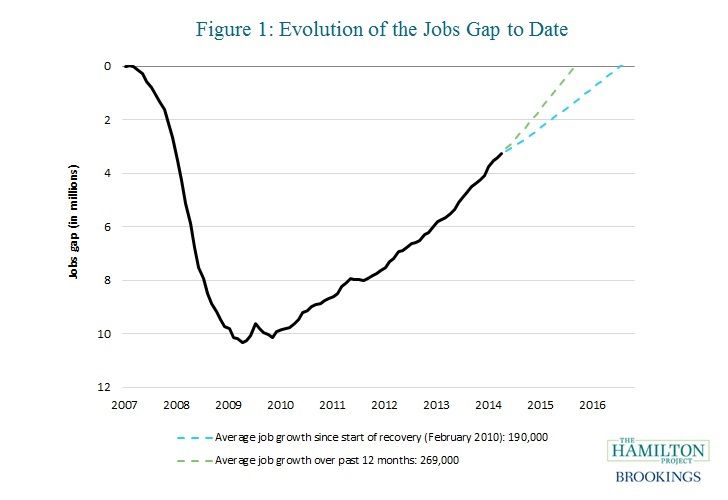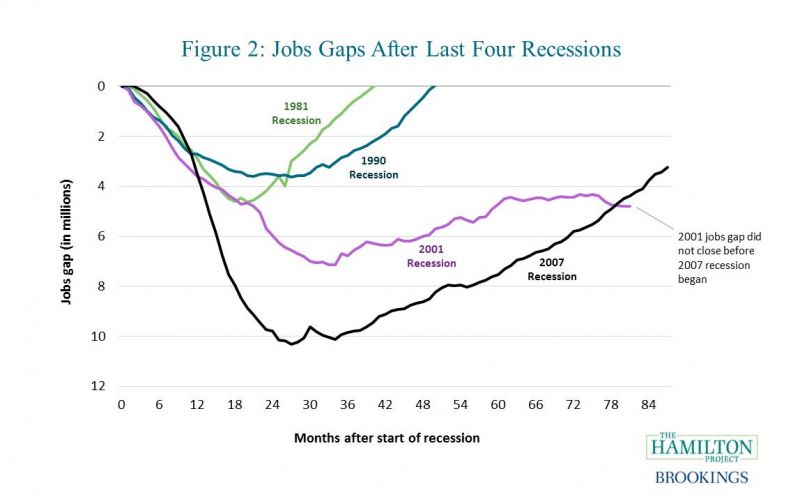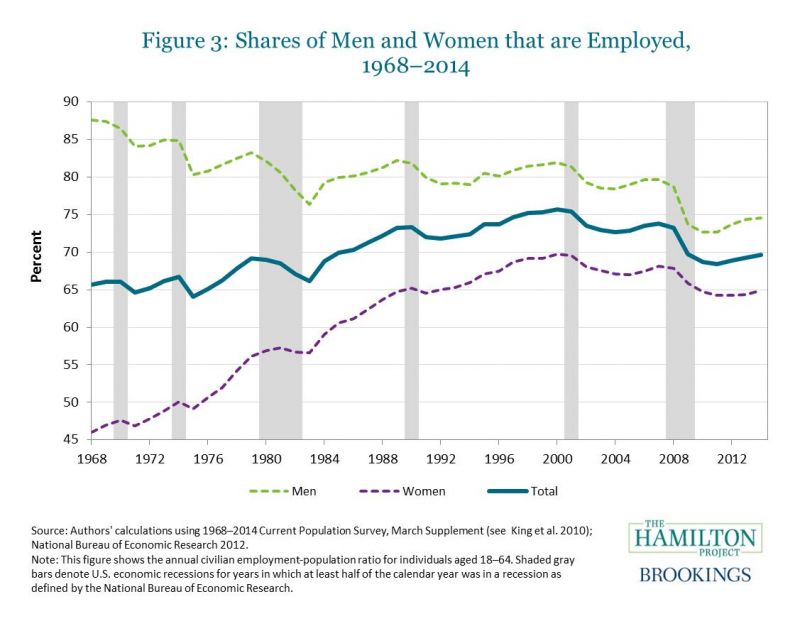According to today’s employment report from the Bureau of Labor Statistics (BLS), employers added 295,000 jobs in February, marking fifty-three consecutive months of positive job creation. Each month, The Hamilton Project calculates America’s “jobs gap,” or the number of jobs that the U.S. economy needs to create in order to return to pre-recession employment levels while accounting for changes in the population. As of the end of February 2015, our nation faces a jobs gap of 3.3 million jobs.[1]
Figure 1 shows the evolution of the jobs gap since the start of the Great Recession. The Hamilton Project forecasts how long it will take to close the jobs gap under two different assumptions of job growth. If the economy adds 190,000 jobs per month, which is the average monthly rate of growth since the recovery began in March 2010, then the jobs gap is projected to close in June 2017 (as indicated by the dashed blue line). Given a more optimistic rate of 269,000 jobs per month, the average monthly rate of job creation over the last 12 months, the economy is projected to return to pre-recession employment levels by July 2016 (dashed green line).
As the recovery continues and the economy adds jobs, the unemployment rate also continues to decline from its peak of 10 percent at the end of 2009. The current unemployment rate of 5.5 percent is only 0.7 percentage points higher than on the eve of the Great Recession. However, there are 8.7 million unemployed Americans, 2.7 million of whom are classified as long-term unemployed, having been without a job for longer than six months. The overall employment-to-population ratio, a broad measure that includes people who have stopped looking for work, has changed little since the end of the Great Recession. It currently stands at 59.3 percent, up just 1 percentage point over the last four years, and far lower than its pre-recession level of 62.7 percent in late 2007.

An Historical Perspective on the Jobs Gap
Under the optimistic job growth scenario depicted above, the jobs gap is predicted to close in July 2016—more than eight years (100 months) after the start of the recession. In this section we compare this long horizon to the duration of previous recessions. By applying the same jobs gap methodology to earlier recessions, we offer some historical perspective.
Figure 2 illustrates the evolution of four jobs gaps, corresponding to the recessions of 1981–82, 1990–91, 2001, and 2007–09. The horizontal axis tracks the number of months elapsed since each recession began. When a line climbs back to this axis, the recovery is complete: enough jobs have been created to return to the pre-recession employment-to-population ratio—adjusted for changing demographics.
Looking at the figure, it is evident that successive recoveries have become longer. The 1981 jobs gap took 41 months to close. The 1990 jobs gap, which was not quite as deep, lasted nine months longer, closing at 50 months. The subsequent two recessions were much more severe, taking over two years to bottom out.
The jobs gap from the 2001 recession never closed at all. In fact, the slight dip at the end of the purple line actually coincides with the onset of the Great Recession. Put differently, even if the current jobs gap of 3.3 million were to close as projected in 2016, employment levels will have returned only to their relative strength of 2007; they would still be significantly below their relative standing in 2000.

Examining trends in the employment-to-population ratio—the share of the population at work—offers some important context for understanding the relatively rapid closing of the earlier jobs gaps, and the fact that the 2001 jobs gap never reached zero. Figure 3 plots the employment-to-population ratios for men and women ages 18 to 64 combined and also men and women separately from 1968–2014. As illustrated by the middle line in Figure 3 (men and women combined), for both the 1981 and 1990 recessions, the employment-to-population ratio was higher by the end of the recovery than it had been pre-recession. The figure also shows that these increases were driven by women (dashed purple line), with the share of men employed fairly flat between 1980 and 2000.[2]

The employment-to-population ratio hit an historical peak in 2000, with more than 75 percent of the population aged 18–64 being employed (Bureau of Labor Statistics 2015). After 2000, however, the trend in women’s employment reversed and began to mirror the declining employment-to-population ratio of men. These more recent declines, linked with the relatively sluggish labor market in the 2000s, prevented the 2001 jobs gap from closing before the onset of the Great Recession, and, somewhat mechanically, underlie the length of the current recovery.
That the current jobs gap is on track to close next year is in part a consequence of the share of the population at work—even accounting for an aging population—having declined between 2000 and 2007. Put plainly, closing today’s gap is a lower threshold than closing the previous gap.
Economists continue to debate the reasons, both cyclical and structural, behind the falling share of the population that is employed. What is clear, however, is that the economy faces new employment challenges. Despite the spate of recent job growth, the labor market remains far from its position in 2007, let alone its strength in 2000, and there is still ample room for targeted policy interventions to hasten the recovery and address long-term challenges.
Conclusion
Labor market challenges—both cyclical and longer term—present a multi-faceted problem and will require a range of policy interventions. On March 11th, The Hamilton Project will host a public forum to discuss three new proposals commissioned from prominent academic scholars. For the full agenda and to register for the event, click here. The papers will be available on The Hamilton Project website (www.hamiltonproject.org) at 10:00 a.m. on March 11th.
The first panel in the forum will focus on a set of proposals by Morris Kleiner of the University of Minnesota to systematize and harmonize occupational licensing regulation. Together, these proposals aim to reduce the regulatory and economic costs of occupational licensing among states, while increasing employment opportunities and expanding consumer access to services.
A second panel will feature two new proposals by Adriana Kugler of Georgetown University and Michael Barr of the University of Michigan. Kugler proposes three pilot programs that would give job-seekers going through the unemployment insurance system a more seamless transition back to work. Barr advocates encouraging entrepreneurship for minorities and women through programs that promote increased access to capital, networks, and skills.
To date, these targeted proposal ideas have received relatively little policy attention. While none of these proposals alone would close the jobs gap or dramatically increase aggregate employment rates, they are meant to complement, not substitute for, more traditional approaches for stimulating job growth and as such, they offer significant potential to broaden job opportunities for more Americans.
References
Goldin, Claudia. 2006. “The Quiet Revolution That Transformed Women's Employment, Education, and Family.” American Economic Review 96 (2): 1–21.
Harris, Benjamin, Brad Hershbein, and Melissa Kearney. 2014. “An Update to The Hamilton Project’s Jobs Gap Analysis.” The Hamilton Project, Brookings Institution, Washington, DC.
King, Miriam, Steven Ruggles, J. Trent Alexander, Sarah Flood, Katie Genadek, Matthew B. Schroeder, Brandon Trampe, and Rebecca Vick. 2010. Integrated Public Use Microdata Series (IPUMS), Current Population Survey (CPS): Version 3.0 [Machine-readable database]. Minnesota Population Center, Minneapolis, MN.
National Bureau of Economic Research (NBER). 2012. “US Business Cycle Expansions and Contractions.” National Bureau of Economic Research, Cambridge, MA.
1. This post originally reported a jobs gap of 4.0 million for February 2015. This estimate was revised in February 2016 to correct a data entry error.
2. The growth in labor force participation and employment of women is one of the most important trends in the labor market in the second half of the 20th century. For an excellent and succinct background on this growth, see Goldin 2006.

